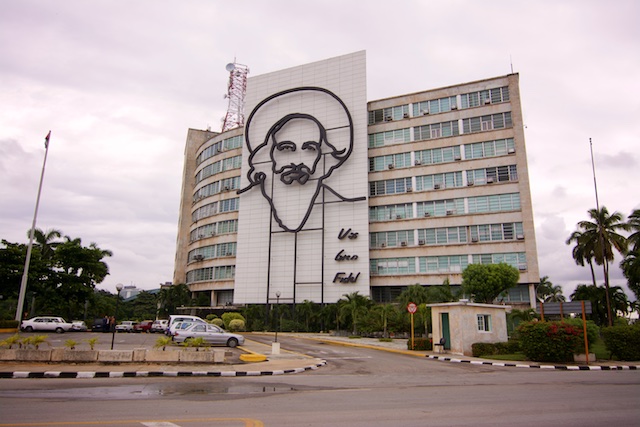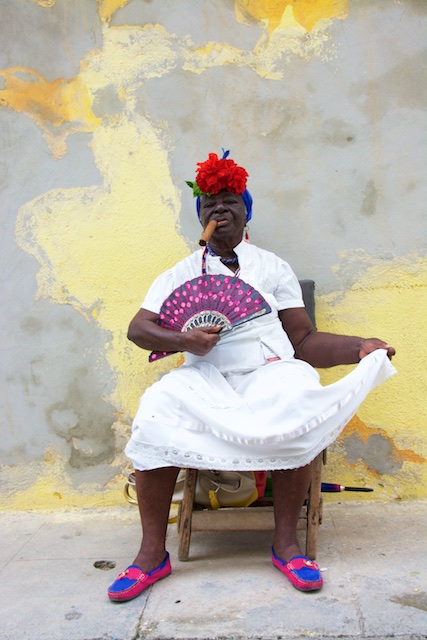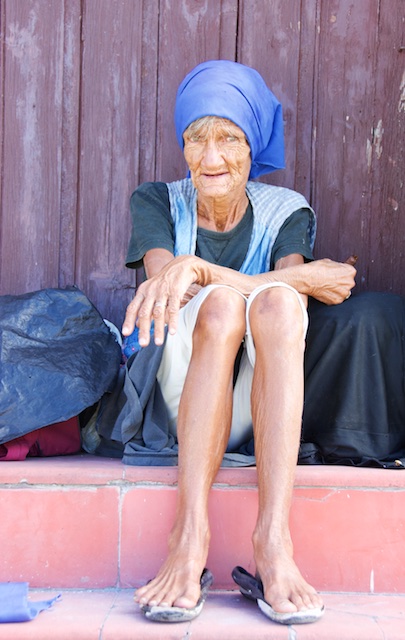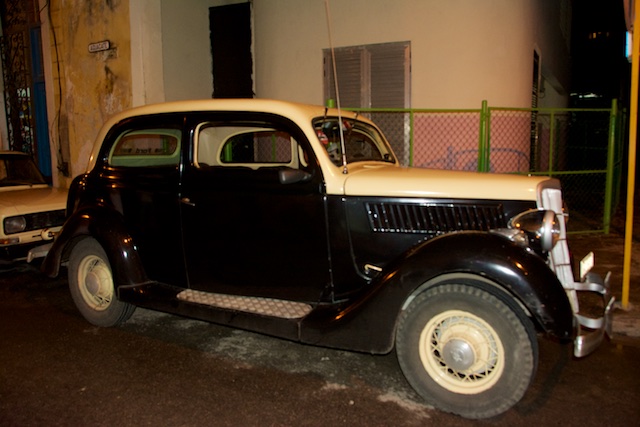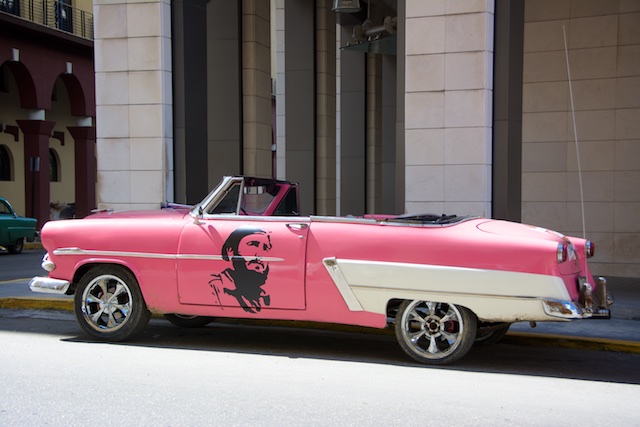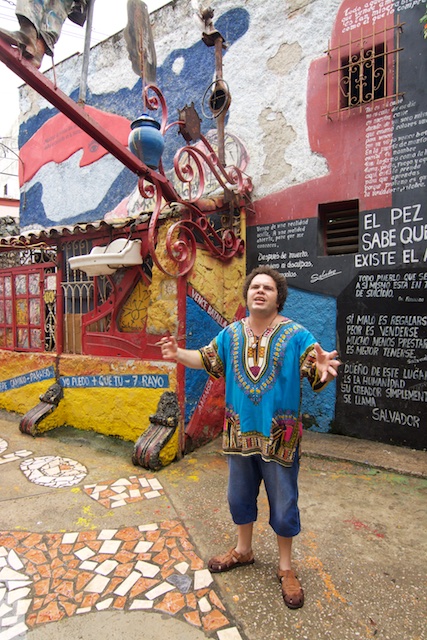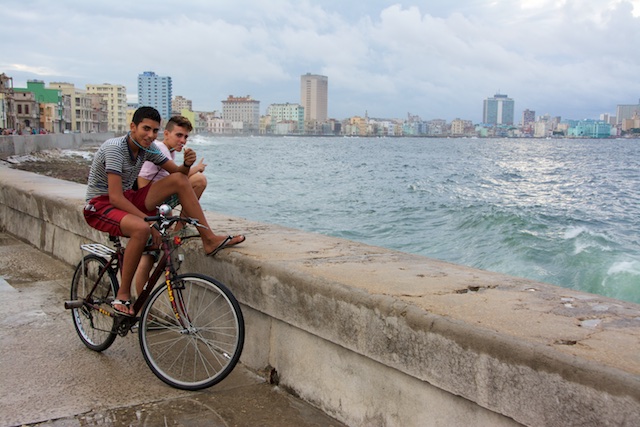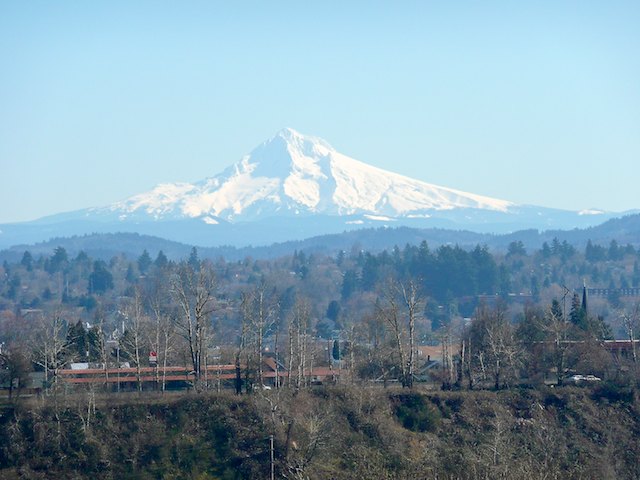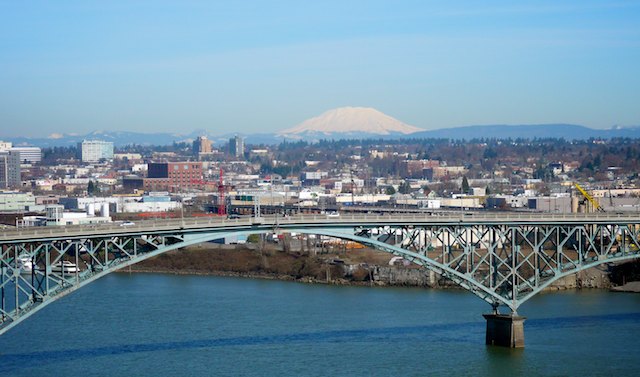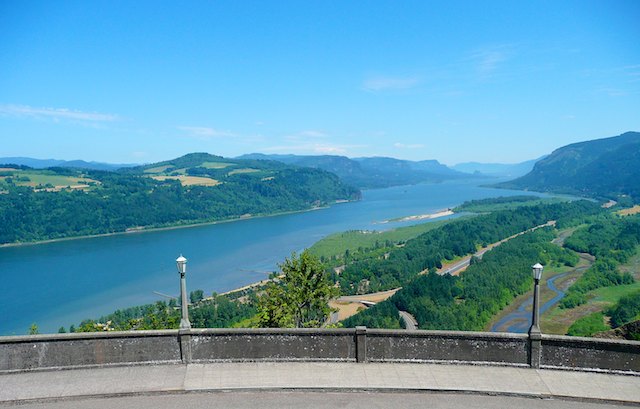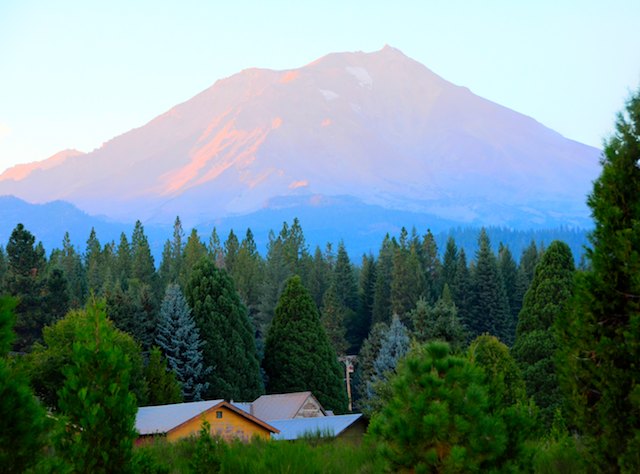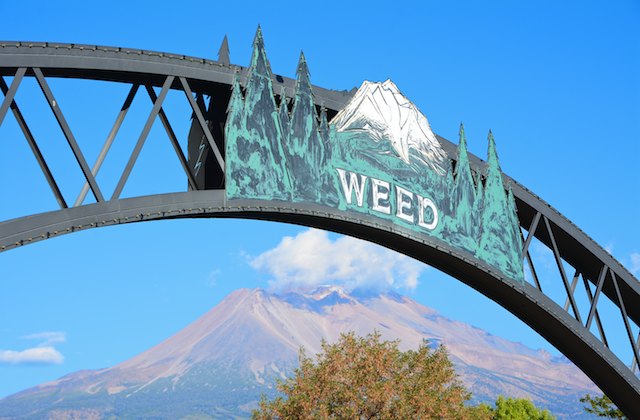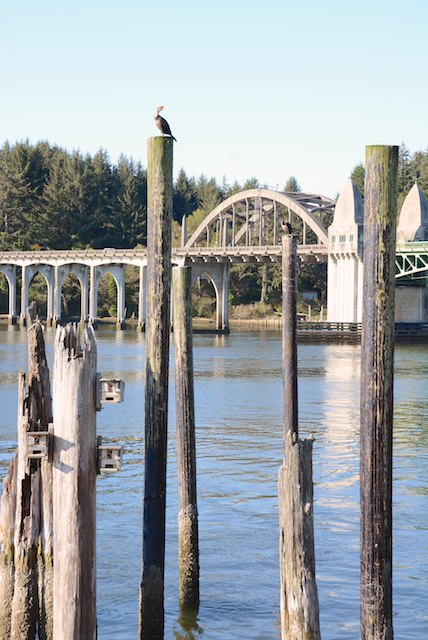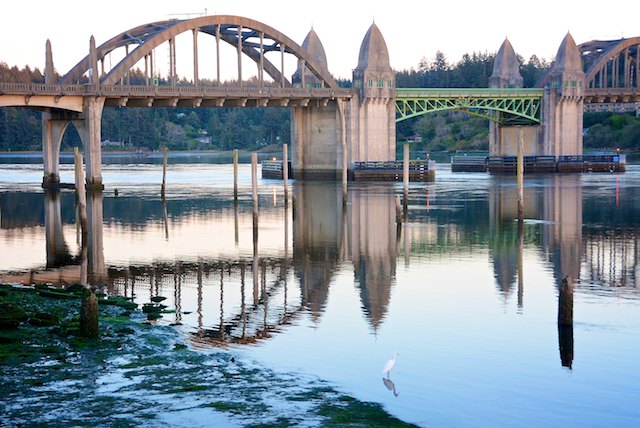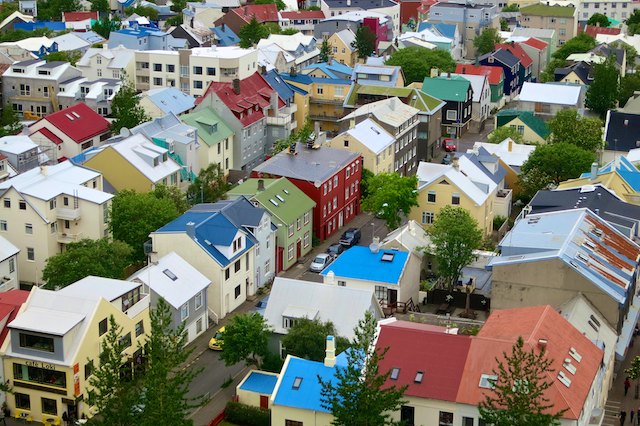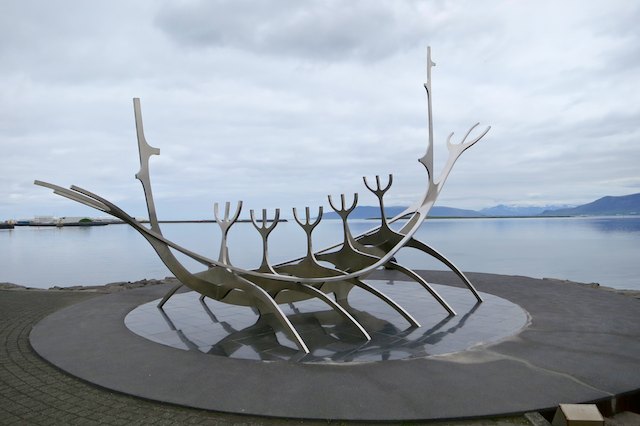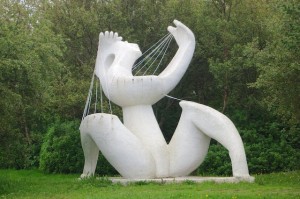My room-mate in Cuba occasionally snores. It’s the same room-mate I have in Oak Park, but when he’s traveling and he has to be up for an early departure he worries that he won’t sleep soundly so he takes a “sleep aid”. (Ambien.) Some of you, especially those of you similarly afflicted with departure anxieties and who are also in possession of a prescription for it might know and even have personal experience with this particular drug. If not, be aware: Ambien, after a few nights, is known to transform a normally civil, circumspect human being into an unrecognizable and vituperative evil golem. Ingestion of Ambien suspends all normal, desirable inhibitions… in some patients. (This warning isn’t provided by the manufacturers.)
Example: two nights running, in the middle of the night, in my otherwise comfortable and pleasingly quiet habitacion, at the Melia Cohiba Hotel in Havana, Mr. Golem decided it was a great idea to bust out into a rather loud, obscene version of an old Elton John song that was stuck on replay in his altered consciousness. “WHAT DO I HAVE TO DO TO GET A _____ _____? WHAT DO I HAVE TO DO? WHAT DO I HAVE TO DO-OO-OO?…” (Use your imagination to fill in the blank. It isn’t the first thing you’d think of from the ordinarily supremely cultured source if you know him. My dear departed Mum would call it “filth”.) Here’s the thing with people who take Ambien for a number of nights running. You can’t wake them up and, more importantly, you can’t shut them up.
Lest you think this intro is in any way irrelevant to a Desto postcard from Cuba, let me enlighten you. In Cuba, (at least in the Melia Cohiba Hotel), the construction standards seemed to reflect (exactly) the kind of inattention to any degree of sound-proofing that you’ve seen represented in every film you’ve ever seen about “Communist” countries. (I guess in addition to the obvious cost considerations, the total audio transparency between walls made it much, much easier for “the party” to keep tabs on “the people”.) You can hear the folks in the next room breathing, especially if they are breathing hard, which, I’ll admit, can sometimes provide for some entertaining episodes. So anyway, in this instance, I was not at all alone for my room-mate’s impromptu, 3 a.m. song spree. Our comrades in room 1221 were likewise serenaded. Thank god we were at the end of the hall so we only had neighbors on one side. The porosity of the adjoining wall also allowed me to hear the riotous laughter from the two lovely divorcee ladies from New York, (also on our tour). The first night they laughed. Night #2 wasn’t quite as amusing. Let’s just say that breakfast was a bit awkward. And, none of us was able to represent the U.S.A. as the usual chipper, well-rested American senior citizens we might have otherwise, sans the Elton John cover concert. Except for my room-mate who slept through his entire show. He was fresh as a daisy both mornings with complete amnesia.
So, basically there are two ways to go to Cuba as an American citizen. Legally and illegally. You are free to book a flight from another country, (usually the scofflaws go in from Mexico or Canada), and thus you avoid the unpleasant red tape that prohibits the U.S. citizens from re-entry when they want to come home. I know many folks who have done this. The only downside is you don’t get your passport stamped in Cuba because you aren’t “really there” at all. You are in Canada or Mexico. Wink, wink. However, as the U.S. teeters on the brink of lifting the embargo on Cuba, there exists a burgeoning tourist industry involved in what is commonly known as “people to people ministries” and by applying for and being granted a “license” to travel inside Cuba, ($$$$$$) you can go in with a tour group as an American and you get a stamp and you are a “legal” tourist. A multi page information packet informs you of the decorum you must display while there and also the restrictions. For instance you are forbidden to purchase anything in Cuba and transport it back to the states. Penalties are high if you try and get caught. Exceptions are made for “educational” materials. Cuban cigars are not educational but CDs are. Books are too, but not books published prior to the revolution. You will be relieved of those if you try to smuggle them in. And, possibly shot on sight for trying. (Just kidding, but we were warned that this is considered a very serious crime, so utilize the Un-Nike injunction…Just Don’t Do It.
Such tours are conducted to expose American tourists to the new, modern Cuba. Cuba under Raul. Fidel has relinquished party power to his brother because he is currently under the weather, although he still writes (uh huh) a column in the only news publication, Granna International, that you can get. In fact, Fidel “wrote” a cogent if critical piece for page 3 of the 8 page current issue of Granna entitled “That Which Can Never Be Forgotten” citing a recent article in the New York Times liberally. (Who knew that Fidel subscribes to the NYT?) You are right to assume that when Fidel says “never”, he means never. It’s as if 1957 was just yesterday.
On these types of tours there is very little opportunity for independent exploration. You are bound to your guides, one American and one Cuban and I must say that they are truly spectacular. Informed and candid and helpful. And really, really, unbelievably patient. I believe every person on the bus except one was in possession of an AARP card if you get my drift. Can you imagine a more “challenging” occupation than corralling 23 AARP members in a somewhat hostile foreign desto? I cannot. I give the guides very high marks for grace under the enormous pressure of keeping us all together with a ratio of 1 to 11.5. (Good job, Jeff and Ya!) I say “somewhat hostile” because, although our experience was entirely free from bad vibes, one Cuban did refer to us as “lovely enemies”.
In the evenings you are allowed to venture off to dine independently if you choose, even though the cost of your evening meal is included in the price of the tour and you sacrifice that money to the tour company. (We thought it worth the small sacrifice since how often do you get to Havana?) You can also contract one of the many “classic antique” American cars that Cuba is known for as a taxi to your restaurant. We did so twice. Once in a 1935 sedan of unknown make and model and once in a 1957 Chevy.
Where previously, after the Revolution of 1959, all business ventures were owned by the state and all business policy was really Communist Party policy, Cuba has recently begun to allow small business ventures of a capitalistic nature. Naturally the first of these are restaurants and the taxis necessary to get the burgeoning tourist hordes to those restaurants. Mostly the small eateries are Paladors, private homes that put up a few tables and serve the tourist trade and the more well heeled Cubans. (The growing entrepreneurial class.) We were told by our new Cuban friends that the uniform salaries of the professions are so low that the taxi drivers and the waiters in the restaurants are often times doctors or engineers moonlighting to advance their standard of living. I don’t know if there’s a Yelp! Cuba yet, but I’m positive that if there is, the Paladors are killing the state owned restaurants on Yelp! The food, the atmosphere, the service in the Paladors was world class. The state owned restaurants? Think hospital cafeteria or maybe the “cafes” in the U.S. national parks and you have a glimmer of the comparison. Fidel will blame the embargo. Everything inferior or bad that occurs in Cuba is a direct result of the embargo. Your kid fails Algebra? Your mother in law doesn’t like you? You are losing your hair, or your mind? The embargo is to blame. The young people make fun of this kind of scapegoating and it is a kind of humor that separates the Cuban generations. Another feature that appeared vastly different between the millennials and their grandparents is the fading of paranoia. The twenty somethings are openly candid, even mildly critical of the government, but people say forty and up still look over their shoulder before they tell you that, yes, there is crime in Cuba.
Perhaps it is a result of growing up with bitter and disillusioned grandparents who once had great hopes for the party and the people, but now see crony capitalism return to Cuba, especially Havana, with a vengeance. Who can say for sure?
We had some interesting sociological questions and indeed the tour arranged for a lovely social psychologist to provide us with a captivating lecture one day. Here’s just some of what I learned in my three point five days in Cuba:
Though a communist country, many Cubans are somewhat religious and they are now free to practice their religion. Many Cubans, not only the descendants of slaves, (those “Black Cubans” whose families have not intermarried with the Spanish enough to be noticeable), but also light skinned folks, “whites” and “mulattoes”, practice the ancient African religion known as Santeria. We were treated to a brief description and history of Santeria inside a “gallery” of wildly colorful murals, by a famous Cuban artist who may or may not have been “crazy”. (Not my term, his assistant admitted that the line between genius and nutso is not always easy to determine for certain. Think of Gaudi. Think of Gauguin.) The demo of the various “gods” involved in Santeria was a theatrical melding of a Roman Catholic high mass, a Chippendales/Hooters stage show, a 1960s men’s movement drumming ceremony with a little snake handling Baptist preacher action in the middle of it all. Everything that makes religion great. And, oh, the mandatory “collection” was taken at the end. (Great Big surprise there. Nope.) The devotees of Santaria go through some kind of secret procedure where-after they then dress all in white and wear white turbans on their heads for a solid year. No mention of what kind of underwear, magic or otherwise, was forthcoming and, I didn’t ask.(I know, you’re shocked.) You could see the devotees of Santeria everywhere in Havana. We also were taken into a Cathedral where a few people appeared to be saying prayers and more than a couple candles had been lit, so the intrepid Catholics have worn the Communist party down some although in no way was there a large visible clerical presence, but you don’t know what will happen. Since Fidel eased up on Catholicism in 1992 and especially since the Pope’s visit in 1998, tons of Catholics have come out of the closet. Our guide told us that there are a few thousand Cuban Jews in the country, a couple of synagogues, a smattering of Muslims, at least one Mosque, and plenty of people who consider themselves “Christian” but don’t attend church on the reg.
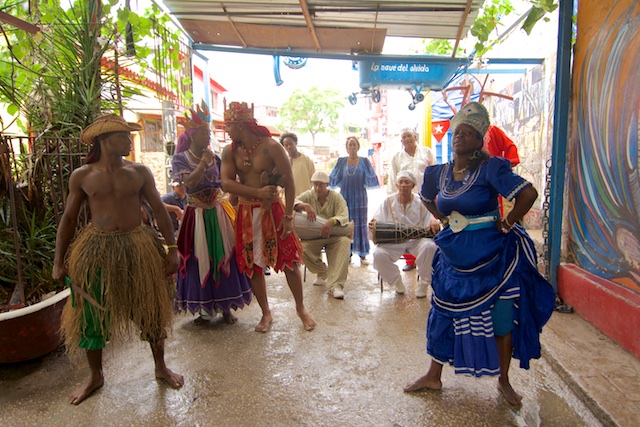
Public education in Cuba is free and attendance is compulsory until about age 14 or grade 9. The universities are free and ostensibly available to everyone, but the admittance exams are highly competitive and, as in the US, those kids who are lucky enough to come from backgrounds that will be supportive of education are generally “advantaged” even though things are supposed to be “equal for all”.
On other social fronts Cuba is not unlike the U.S. Homophobia is prevalent even though it is legal for people to engage in “non-commercial” homosexual acts. Gay people cannot legally marry and gay men especially are targeted for harassment.
Health care is free and universal. It is illegal to practice “medicine” as a business enterprise in Cuba. Nobody wants to be a doctor in Cuba anymore because the salaries of the professions are so low and societal prestige will always be more an outgrowth of relative economic wealth as opposed to simple human virtue. (Am I repeating myself? Forgive me, but Fidel should have seen that one coming.)
Abortions are legal and very common. The most popular forms of birth control are the IUD and condoms. The average Cuban woman only bears 1.3 offspring currently meaning that the Cuban population is both declining and getting older.
One young Cuban woman told us that in general young Cubans are apolitical. (Maybe even hopeless.) They see the party as a fact of life. Che wasn’t even a Cuban. In some ways he means little more to them than a really nice guy whose image sells t-shirts to the tourists.
Given that history has proven that revolutions are always produced by the young, the passionate and the disaffected, it’s highly unlikely that Cuba will experience another one any time soon

